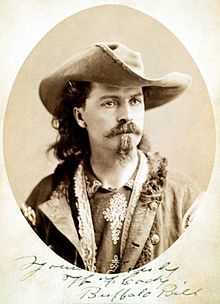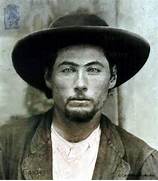May 27, 1837
One of the true legends of the west is born today in Homer, Illinois. His given name is James, but he will be forever known as Bill.

He will become a stagecoach driver, Army scout, hunting guide, an actor – a bad one, at that — a lawman, and a gambler. He will fight a bear, and become involved as a participant in one of the most iconic events of all western folklore. He will be known as a dandy and ladies’ man, and one of the most deadly shootists of all time. He will be friends with one of the most famous soldiers of all time, and one of the most famous showmen of the frontier. He will know on a first name basis some of the most well-known figures of the west, and he will always be associated with his last card game.
James Butler Hickok is an American original. He will serve with the Union Army as a scout, courier, and spy, and be successful at all of them. He wasn’t afraid of anything, including bragging about him-self, and he wasn’t intimidated by anyone either. He moved to Leavenworth in the Kansas Territory in 1855, at age 18, following a fight with a Charles Hudson, during which both men tumbled into a canal, believing they had killed the other one. Hickok fled the area and joined “General” Jim Lane’s “Free State Army” (also known as the “Jayhawkers“), a vigilante group then active in the Kansas Territory. While he was serving as a Jayhawker, he met young 12-year-old William Frederick Cody (later known

as “Buffalo Bill”) who, despite his youth, was serving as a scout for the U.S. Army during the Utah War.
One of the major events in Hickok’s life took place in 1860, when he was badly injured by a bear while he was driving a Russell, Waddell, & Majors freight team from Independence, Missouri to Santa Fe, New Mexico. Keeping in mind he frequently told tall tales, according to Hickok’s account, he found the road blocked by a cinnamon bear and its two cubs. Dismounting, he approached the bear and fired a shot into its head, but the bullet only glanced off its thick skull, which only served to infuriate it further. The bear attacked, crushing Hickok with its body. Hickok said that he managed to fire another shot, disabling the bear’s paw. Hickok asserted the bear grabbed his arm in its mouth but he was able to grab his knife and kill it.
While recuperating from the fight with the bear, James experienced another major event in his life. He was convalescing at the Rock Creek Way Station of the freight company. On July 12, 1861, Dave McCanless went to the Station office to demand an overdue property payment

from Horace Wellman, who was the station manager. McCanles reportedly threatened Wellman, and either Hickok (who was hiding behind a curtain) or Wellman killed him. Hickok, Wellman, and an employee, J. W. Brink, were tried for killing McCanles but were found to have acted in self-defense. McCanles was the first man Hickok may have killed.
On July 21, 1865, Hickok and Davis Tutt had several disagreements in Springfield, Missouri about Hickok’s unpaid gambling debts and

competing affections for the same woman (Susanna Moore). Tutt took a watch of Hickok’s who promptly demanded its return and warned Tutt not to be seen wearing it. The next day Hickok saw Tutt wearing the watch and warned him to not cross the town square with it. Tutt challenged Hickok and the two men assumed classic duel stance, facing each other sideways. Their “quick draw duel” was the first of its kind. The “quick draw gunfight” was later fictionalized as a typical action by Hickok, but it is the first known instance of the classic Western gunfight, and in all the documentation and history of the old west, this is the ONLY time it ever happened, the opening of the tv show Gunsmoke not withstanding. However, unlike the stereotypical Hollywood gunfight in which the two combatants stand face-to-face, the two men faced each other sideways, before drawing and firing their weapons. Tutt’s shot missed but Hickok struck Tutt through the heart from about 75 yards (69 m) away. Tutt called out, “Boys, I’m killed” before he collapsed and died.
Over the next 11 years, Hickok served as a lawman at Ft. Riley, Kansas; Abilene, Kansas; Ft. Hays, Kansas; where he kept order based on his fearsome reputation. Few wanted to risk trading shots with Wild Bill, as he never shot to wound and uncommonly accurate when he did. He served as a guide for General Custer, and was a favorite of Libby, the General’s wife. He and Tom Custer, the General’s brother, did not get along. He ‘trod the boards’ for Bill Cody in New York, where he would notoriously shoot close to the legs of the other actors to scare them. He was only shooting blanks but they hurt, nonetheless.
In August of 1876, he was secretly going blind from glaucoma and ophthalmia Hickok had a premon-ition that Deadwood would be his last camp, and he expressed this belief to his friend Charlie Utter (also known as Colorado Charlie) and the others who were traveling with them. On August 2, 1876, Hickok was playing poker at Nuttal & Mann’s Saloon in Deadwood, in the Black Hills of the Dakota Territory. Hickok usually sat with his back to a wall, but the only seat open when he joined the game that afternoon was a chair that would put his back to a door. Twice he asked another player by the name of Charles Rich to change seats with him but Rich refused. A former buffalo hunter, Jack McCall (better known as “Crooked Nose Jack”), entered the saloon unnoticed by Hickok. McCall walked to within a few feet of Hickok, drew a pistol and shouted, “Damn you! Take that!” before firing at Hickok point blank. McCall’s bullet hit Hickok in the back of the head, killing him instantly. The bullet emerged through Hickok’s right cheek, striking another player, Captain Massie, in the left wrist. The murder weapon was a 18 inch “Sharps Improved” revolver.
To purchase a signed copy of Larry Auerbach’s novel “The Spirit Of Redd Mountain”, Click Here
Photo courtesy of wikipedia.com



